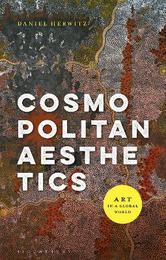
|
Cosmopolitan Aesthetics: Art in a Global World
Hardback
Main Details
| Title |
Cosmopolitan Aesthetics: Art in a Global World
|
| Authors and Contributors |
By (author) Daniel Herwitz
|
| Physical Properties |
| Format:Hardback | | Pages:232 | | Dimensions(mm): Height 216,Width 138 |
|
| Category/Genre | Philosophy - aesthetics |
|---|
| ISBN/Barcode |
9781350075238
|
| Classifications | Dewey:701.17 |
|---|
| Audience | | Tertiary Education (US: College) | |
|---|
| Illustrations |
15
|
|
Publishing Details |
| Publisher |
Bloomsbury Publishing PLC
|
| Imprint |
Bloomsbury Academic
|
| Publication Date |
12 December 2019 |
| Publication Country |
United Kingdom
|
Description
New arts created in the context of new social realities are impacting our traditional ideas about aesthetics. Art, art markets and aesthetics now interact in ways that demand new forms of thought and revision of old. Cosmopolitan Aesthetics presents the first thorough account of the challenges facing aesthetics today in the light of globalization, introducing the history that underpins them. This is an ideal starting point for anyone looking to better understand 21st century art and aesthetics. Beginning with globalization and the nature of global art markets today, Daniel Herwitz offers new insight into postcolonial aesthetics, colonial legacies, cultural property, the problems of global communication and aesthetic diversity, and the uneasy connection between aesthetics and politics, before providing a crucial grounding in 18th and 19th century aesthetics, with discussion of the three great modern aestheticians David Hume, Immanuel Kant and G.W.F. Hegel.
Author Biography
Daniel Herwitz is Fredrick Huetwell Professor of Philosophy, History of Art and Comparative Literature at the University of Michigan, USA where for a decade he directed the Institute for the Humanities. His previously published books include Aesthetics, Arts and Politics in a Global World (2017), the award winning Star as Icon (2008), and M.F. Husain (1988). Herwitz frequently writes for galleries in New York City, London, Cape Town and other places.
Reviews"This book asks how one can reconcile the universalizing theories of post-Enlightenment aesthetics with the current realities of a globalized economy. Herwitz's answer, in short: cosmopolitanism, a dialectic of homogenization and diversity. [He] reconsiders the relationship of contemporary art to sociopolitical events and institutions by circling back to the 18th and 19th centuries of Kant and Hegel and then to Danto in the 20th century. These philosophical inquiries are interleaved with case studies of specific artists, many of whom hail from the Global South and thus provide welcome counterbalance to the still-dominant First World narrative. In Herwitz's telling, 21st-century artistic cosmopolitanism also sheds new light on historical aesthetics, providing a means for reevaluating how the personal and the universal were reconciled in aesthetic theory. These are big, unwieldy topics and Herwitz's clear, conversational style makes the material accessible. That said, it is inevitable that a subject of such scope leaves much territory unexamined and a great deal of art unaccounted for ... The book provides a useful introduction to issues of globalization as it pertains to art. Summing Up: Recommended. Lower- and upper-division undergraduates; graduate students. * CHOICE * This book far extends the usual scope of aesthetic enquiry. It is written with a challenge, to open up the political and social imaginary through the historical and contemporary media of the arts. Its flair and wit, its insight and extensive range raises the stakes in a world market whose design threatens to close down and restrict the promise of the cosmopolitan who refuses any longer to be a colonialist. * Lydia Goehr, Professor of Philosophy, Columbia University, USA * Daniel Herwitz, one of our great authorities on the discipline of Aesthetics, here turns his attention to the ways the question of cosmopolitanism, first put forward by Kant and then called into question by Hegel and others, can-indeed must-- be adapted today if we are to make sense of art practice and reception as these intersect with the global art market. Designed for the general reader as well as for art historians and critics, Cosmopolitan Aesthetics is that rare thing-a truly necessary book. * Marjorie Perloff, Sadie D. Patek Professor of Humanities Emerita, Stanford University, USA * The world according to Daniel Herwitz is endlessly rich, beautiful, and troubled. Cosmopolitan Aesthetics is perhaps his most important book to date, combining his unique philosophical command, political commitment, and aesthetic judgment with his signature electric wit. The result is a riveting and indispensable analysis of art, commerce, and taste in the post-global age. * Michael P. Steinberg Barnaby Conrad and Mary Critchfield Keeney Professor of History, Brown University, USA *
|